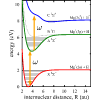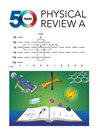Spectral evidence of vibronic Rabi oscillations in the resonance-enhanced photodissociation of MgH+
IF 2.9
2区 物理与天体物理
Q2 Physics and Astronomy
引用次数: 0
Abstract
We study by real-time wave-packet simulations the sequential two-photon dissociation of the molecule, under intense ultraviolet laser pulses of narrow spectral width. By a resonant coupling, one-photon Rabi oscillations are generated between two vibrational levels of the molecule, belonging to two different bound electronic states. These vibronic Rabi oscillations are probed upon absorption of further photons from the same laser pulse, that gradually promote the molecule to a dissociative electronic state. Calculating the energy spectrum of the photofragments explicitly analytically, we elucidate the physical origin of the main spectral features—such as the splitting, shifting, asymmetry, and multipeak pattern—identified by accurate numerical simulations. We find that the pronounced spectral intensity modulations result from the interference of fragment amplitudes that are generated during the distinct Rabi cycles in the upper and lower dynamically dressed states, formed upon the resonant coupling with the laser pulse. These intensity modulations are sensitively influenced by the resonant and nonresonant Stark effects, and can be manipulated by the parameters of the applied laser pulse. Our results contribute to the understanding and control of ultrafast coherent phenomena via the energy spectrum of particles emitted during the dynamical process under investigation.

共振增强型光解离 MgH+ 中振动拉比振荡的光谱证据
我们通过实时波包模拟研究了 MgH+ 分子在窄光谱宽度的强紫外激光脉冲下的顺序双光子解离。通过共振耦合,分子的两个振动级(属于两个不同的束缚电子态)之间产生了单光子拉比振荡。在吸收来自同一激光脉冲的更多光子后,这些振动拉比振荡会被探测到,这些光子会逐渐促进分子进入解离电子态。通过明确分析计算光子碎片的能谱,我们阐明了主要光谱特征的物理来源--如分裂、移动、不对称和多峰模式--这些特征是通过精确的数值模拟确定的。我们发现,明显的光谱强度调制产生于碎片振幅的干扰,而碎片振幅是在与激光脉冲共振耦合后形成的上层和下层动态敷料态的不同拉比周期中产生的。这些强度调制会受到共振和非共振斯塔克效应的敏感影响,并可通过应用激光脉冲的参数进行操控。我们的研究结果有助于通过研究动态过程中发射的粒子能谱来理解和控制超快相干现象。
本文章由计算机程序翻译,如有差异,请以英文原文为准。
求助全文
约1分钟内获得全文
求助全文
来源期刊

Physical Review A
物理-光学
CiteScore
5.40
自引率
24.10%
发文量
0
审稿时长
2.2 months
期刊介绍:
Physical Review A (PRA) publishes important developments in the rapidly evolving areas of atomic, molecular, and optical (AMO) physics, quantum information, and related fundamental concepts.
PRA covers atomic, molecular, and optical physics, foundations of quantum mechanics, and quantum information, including:
-Fundamental concepts
-Quantum information
-Atomic and molecular structure and dynamics; high-precision measurement
-Atomic and molecular collisions and interactions
-Atomic and molecular processes in external fields, including interactions with strong fields and short pulses
-Matter waves and collective properties of cold atoms and molecules
-Quantum optics, physics of lasers, nonlinear optics, and classical optics
 求助内容:
求助内容: 应助结果提醒方式:
应助结果提醒方式:


